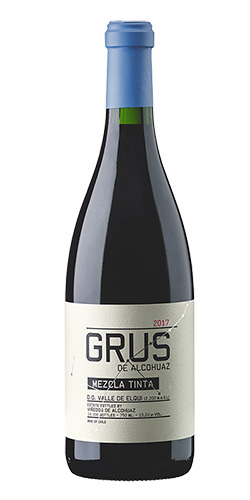WORLDVIEW
Viñedos de Alcohuaz is located in the Andes Mountain Range, 30° parallel south latitude, between 1,650 and 2,206 meters of altitude. Wines of Viñedos de Alcohuaz are wines of altitude, with the unmistakable effect of three fundamental factors: sun, granite floors and altitude.
These three factors produce grapes of unusual thick skin, so in Alcohuaz we do the initial pressing of the grapes like in ancient times, grape-treading. This technique is essential in our winemaking process, since it allows us to get a tannic balance that only human sensibility can get.


They say there is a portal in the north of Chile. A concave-convex bridge in the sky membrane, where divinity and humanity connect and where information and understanding make synapses.
A chrysalis where cardinal directions constellate with each other, the ideas of celestial planimetry in a stellar metamorphosis. So they say.
The secret of Elqui lies not only under our feet, but also on our heads. When looking up to the order offered by the stars it is clear that here, the word territory is the union of earth and sky.
They say each star is a word. A message with chromatic complexities, tactile richness and unrepeatable melodies of a xylophone.
Constellations are sentences, galaxies are chapters and the universe is the complete story: the endless story of sacred geometry where the sky communicates with the earth.
Elqui hides as many mysteries as stars. In the last decades, it has become a meeting point for astronomers, winemakers and travellers of the world, all attracted by its inexplicable magnetism.
HARVESTS
It was a special vintage, there was no snow during wintertime and rainfall was only half of what we get on an average year. Summer was dry and sunny. During the aging process, wine was always very deep, vertical and with a lot of graphite.
Both climate and harvest can be appreciated in the bottle, with notes of black olives and fruits, showing the sun of this summer. The harvest ended on March 29th.
A warm vintage, with a rainy and very snowy winter, followed by a very dry, warm and difficult summer. We got high temperatures in January that left us with very ripe fruit when the harvest started.
Wines are larger, softer, and more mature, with a verticality that is typical from the region, and which provides the final balance to wines. Harvest ended March 19th.
Just like 2012, 2013 was a warm year, almost with no rain, no snow and a very dry summer with high temperatures. It was a great year just like 2012.
The wine (RHU) is the reflection of this: soft, deep and with the acidity that a place like Elqui Valley provides. Harvest ended on March 13th.
It was a special vintage, with plenty of snow and some frosts, but with almost no rain, reaching historic low figures. Summertime was quite fresh. The results were very vertical wines and with good acidity.
After a few seasons making wine in the area, we decided to have the harvesting process earlier providing more freshness, more verticality. The harvest ended on March 5th.
A particularly cold year, with snow and little rain. The summer had historical low temperatures. The wines show the freshness of the vintage, thirst quencher wines that can also age.
It was a great year for Viñedos de Alcohuaz. The harvesting process of Syrah ended on February 25th and on March 20th for Carignan.
It was a high quality vintage with smaller amount of grapes. It was affected by a 30 centimetre snow on October 14th that affected the outbreaks already grown.
We produced with very good quality wine, harvesting a month later than planned and with only 18% in volume compared to what we expected. Harvest ended on April 7th for Syrah and April 27th for Carignan.
This year, the harvesting period was the earliest for almost all parcels in Alcohuaz. Malbec, for example, was harvested on February 14th. There was no snow during winter and summertime was dry, with a maximum average temperature in January of 29.7ºC, the highest in recent years.
In spite of being a warmer year, wines from 2017 did not lose their usual tension and freshness. 20% to 60% of whole cluster was used during fermentation process to provide more texture.








